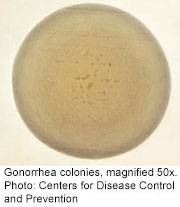
TUESDAY, Jan. 8 (HealthDay News) — The sexually transmitted disease gonorrhea is becoming increasingly resistant to available antibiotics, including the last oral antibiotic used to treat the bacterium, new Canadian research shows.
In a study of nearly 300 people infected with Neisseria gonorrhoeae, the researchers found a treatment failure rate of nearly 7 percent in people treated with cefixime, the last available oral antibiotic for gonorrhea.
“Gonorrhea is a bacterium that’s phenomenal in its ability to mutate quickly, and we no longer have the same abundance of options anymore,” said study author Dr. Vanessa Allen, a medical microbiologist with Public Health Ontario in Toronto. “We need to start thinking about how we give antibiotics in view of a pipeline that’s ending. I think gonorrhea will become a paradigm for drug resistance in general.”
Another expert agreed.
“We’ve been lucky. For quite some time, we’ve had treatments for gonorrhea that are simple, cheap and effective, and a single dose,” explained Dr. Robert Kirkcaldy, a medical epidemiologist with the U.S. Centers for Disease Control and Prevention, who wrote an editorial accompanying the study. “But now we’re running out of treatment options, and there’s a very real possibility that there will be untreatable gonorrhea in the future. This is a serious public health crisis on the horizon.”
The CDC is so concerned that the agency issued new treatment recommendations last August. The CDC advised doctors to stop using cefixime to treat gonorrhea, and instead use the injectable antibiotic ceftriaxone. Ceftriaxone is in the same class of antibiotics as cefixime.
The CDC has also recommended that physicians closely monitor their patients to ensure that the treatment is working, and to add a second class of antibiotics to treatment if they suspect the ceftriaxone injection hasn’t knocked out the infection.
Gonorrhea is an extremely common infection. More than 320,000 cases were reported in the United States in 2011. Experts suspect that the actual number of infections is closer to 700,000 because the infection often has no symptoms, Kirkcaldy said.
If left untreated, gonorrhea can cause infertility in both men and women and increases a person’s susceptibility to HIV. It can cause pelvic inflammatory disease, a painful condition that causes scarring in a woman’s reproductive tract that increases the risk of ectopic pregnancy (a pregnancy outside the uterus), according to the CDC. Allen added that untreated gonorrhea in pregnant women can lead to an eye infection or even blindness in newborns.
Since the 1940s, gonorrhea has been outsmarting the antibiotics used to treat it. Gonorrhea is resistant to sulfonamides, penicillins, tetracyclines and fluoroquinolones, according to Kirkcaldy.
After hearing anecdotal reports that gonorrhea was now developing resistance to the last oral antibiotic available, and hearing from Japanese researchers that they were starting to see cefixime resistance, Allen and her colleagues reviewed nearly 300 past cases of gonorrhea infection.
From that sample, 133 came back to be retested. Nine people (6.8 percent) were found to be cefixime-resistant. That leaves ceftriaxone as the only antibiotic to which gonorrhea hasn’t developed a significant resistance. Given that it’s from the same family of antibiotics, however, Allen said resistance to ceftriaxone is likely inevitable. The only real question is how long it might take.
Kirkcaldy echoed the same urgency.
“We need to prevent untreatable gonorrhea as a reality, and that means we urgently need new treatment options,” he said. “The antibiotic pipeline has been drying up. We need to jumpstart research and investment to develop new drugs and new drug combinations.”
On an individual level, he advised prevention efforts. “Use condoms consistently and correctly. Practice monogamy. Talk to your doctor about whether or not you need to be screened,” he suggested. “Many infections cause no symptoms. But if you treat an infection quickly, you decrease the chances it will be transmitted to partners.”
Results of the study are published in the Jan. 9 issue of the Journal of the American Medical Association.
More information
Learn more about gonorrhea and how to prevent it from the U.S. Centers for Disease Control and Prevention.

